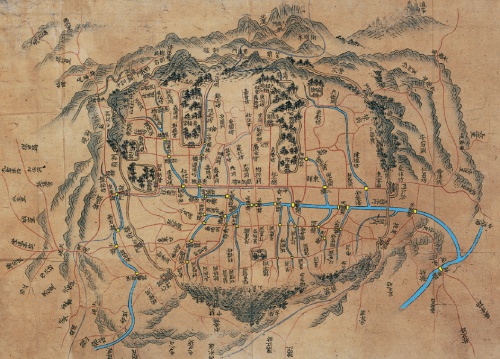Seoul - 5.4 Waterways and Reviving Stream that have Disappeared
| Understanding Korea Series No.4 | ||
| ← Previous | Seoul | Next → |
| 3) Disappearance and Regeneration of the Traditional Urban Residences | 4) Waterways and Reviving Stream that have Disappeared | 5) Restoration of the Destructed Ecological Environment |
The [Map of the Capital] (circa 1720) shows little waterways from mountains and hills that surround the city walls join the stream (Cheonggyecheon) and ultimately flow into the Han River. Eighty-six bridges, 76 within the city limit and 10 more outside the city (late Joseon Dynasty), were hung over the intersections of these waterways and roads. Hanseong indeed was a ‘city of water’ with more than 10 waterways within the city, and more waterways surrounding the city. Here the citizens met and passed over the waterways in their daily city life. But most of these waterways disappeared from today’s downtown Seoul as many are covered, and the uncovered ones have dried up making it difficult to witness any naturally flowing water.
Most of the waterways within the city began to be converted into culverts since the late Joseon Dynasty and Japanese Colonial Period with the exception of Cheonggyecheon, which was expensive to convert due to the relatively wide width. Cheonggyecheon and the southbound and the northbound streams that joined Cheonggyecheon were covered and they all disappeared from the ground surface between 1958 and 1970. Most of the streams surrounding the city were also covered during the urbanization process from 1960s and 1980s. 24 out of 36 streams in Seoul’s city limit or 31.3% of the length of the stream were covered. The covered areas were mostly used as roads, and it helped relieve traffic congestion. The noxious smell produced from releasing polluted water directly into the stream was also reduced. There were certain economic benefits to utilizing the areas near the covered waterways, and the cluttered environment was cleaned up and improved.
In the 1990s polluted streams like Yangjaecheon was restored to a state that is close to its natural state, and in the 2000s the restoration projects on covered streams within the city such as Cheonggyecheon and Seongbukcheon were launched to improve the water quality and to restore the natural characteristics of the streams. The restoration of Cheonggyecheon in particular grabbed national attention due to its historical and locational importance, and it was the main pledge of the 2002 mayor-elect of Seoul, Lee Myungbak. The Cheonggyecheon Restoration Project began in 2003 with the demolition of the overpass structures and was completed rather quickly without any interruptions in 2005. The length of the restored waterway was 5.8 kilometers, and the waterway was constructed as a man-made stream with water from the Han River and underground. Neither the historical remains such as Supyogyo Bridge and Gwangtonggyo Bridge nor the natural streaming state of the Cheonggyecheon were restored in the process: Cheonggyecheon’s original value was not completely restored but Cheonggyecheon was reborn as an urban stream in the form of ‘waterway made of concrete.’
The citizens of Seoul welcomed the restoration that made the flow of clean water possible through the development regiment even though the historical and ecological value of Cheonggyecheon was not fully restored. In fact it was frequently introduced as an example of environmentally sound and sustainable revival of an urban stream. With the restoration of Cheonggyecheon many stores that were in the backward commercial centers around the area relocated to surrounding areas, and new business districts were established in Cheonggyecheon area between Jongno and Euljiro. Not only candlelight protests but also other events such as World Lamp Festivals are held in the Cheonggyecheon Plaza. It is appreciated as an urban resting space that many citizens of Seoul and tourists, foreign and domestic, visit.
